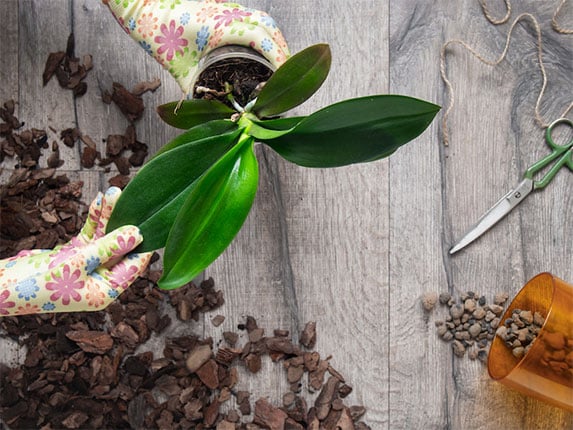
Potting medium does more than simply root an orchid in place. It allows roots to breathe and provides proper air circulation, moisture, and nutrient levels. The right medium also gives your plant the proper drainage to prevent water logging. But with such a variety of potting media available, how do you know which is the right one?
When you bring an orchid home from the store, it is planted in a specially mixed orchid growing medium created specifically for the grower. However, orchids will thrive in any of the commercial orchid potting media sold at retailers and garden centers. As long as the product states that it is specifically formulated for orchids, you can use it to repot your orchid.
First, we do not recommend repotting your orchid when you bring it home, especially not when it is blooming. Most 5-inch orchids do not need to be repotted for 1-2 years after you bring them home.
If you are feeling creative and do not want to purchase potting medium at the store, you can create your own.
Orchid-growing media can be created by blending any number of different organic materials. Phalaenopsis orchids can be planted in quite a wide variety of materials, including fir bark, sphagnum peat, tree fern, charcoal, sphagnum moss, perlite, coconut husk chips, diatomite, or any mixture of these materials. Coarse-cut materials are used to promote proper root aeration, water and nutrient retention, and root drainage. Stability, weight, consistency, and cost are other considerations when mixing orchid potting media.
Some orchid hobbyists enjoy experimenting with different potting materials and mixing their own orchid media. Every orchid grower has their own ideas about what makes the perfect orchid potting mix.
Phalaenopsis orchids should be repotted every one to two years to refresh the potting medium and provide a healthy growing environment for the orchid. In the U.S., orchid bark and sphagnum moss are the two most common components in commercial orchid potting media, but a wide variety of other materials may be added to the mix.
Orchid bark, the bark of Douglas fir or redwood trees is inexpensive in the U.S., drains quickly and deteriorates slowly, requiring repotting only once every 2 years.
Sphagnum moss is often paired with orchid bark because it helps retain water, preventing moisture from draining away before it can be absorbed by the plant’s roots. It is also believed to help prevent fungus. Select long-fibered, premium grade moss that is free of debris. Because it breaks down quickly, moss must be replaced annually.
Tree fern, the rigid, dark-brown roots of a Central American fern known as the “tree fern,” is easy to use and can stay fresh for up to three years. Its drainage properties are like that of orchid bark; but because of its greater expense, it is less commonly used in the U.S. than bark.
Osmunda fiber was once the orchid potting material of choice, but expense and limited availability have dropped it from favor. It is also arduous to cut into potting-size pieces and must be carefully aligned to drain correctly, making it an impractical choice today.
The size of your orchid will affect the grade of your medium. One of the top orchid growers recommends medium grades of a bark-fir mixture (50 percent bark and 50 percent fir) for orchids in three and four-inch pots, coarser grades for orchids in six-inch pots and chunk-grade material for orchids in pots eight-inches or larger. For miniature Phals often sold in pots about two inches in diameter, sphagnum moss may be the best choice for potting medium. This is because the chunky growing media used in larger Phals is simply too large for their smaller pots.

Copyright Just Add Ice® Orchids 2023